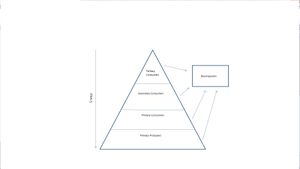FeedingGuilds: Difference between revisions
RichaSolanki (talk | contribs) |
RichaSolanki (talk | contribs) |
||
| Line 22: | Line 22: | ||
For coral reefs: | For coral reefs: | ||
[[File: | [[File:Tropic.jpg|thumb|center|Trophic levels]] | ||
Begin with primary producers on the bottom of the pyramid, examples: phytoplankton, zooxanthellae, seaweed. Next up is primary consumers, examples: zooplankton, sea turtles, sea urchins. Above that is secondary consumers, examples: barnacles, damsel fish, puffer fish, some crabs, whale shark. Top spot is tertiary consumers, examples: larger reef fish, sharks, dolphins, barracuda, moray eel | Begin with primary producers on the bottom of the pyramid, examples: phytoplankton, zooxanthellae, seaweed. Next up is primary consumers, examples: zooplankton, sea turtles, sea urchins. Above that is secondary consumers, examples: barnacles, damsel fish, puffer fish, some crabs, whale shark. Top spot is tertiary consumers, examples: larger reef fish, sharks, dolphins, barracuda, moray eel | ||
Revision as of 01:24, 15 April 2014
Outline for Feeding Guilds and Trophic Levels:
Feeding Guilds
Any group of species that exploit the same resources, often in related ways. Defined according to the locations, the attributes, and the activities of their component species. For coral reefs, main categories: Producers, Consumers, and Decomposers
Producers
Organisms that are capable of making their own food and are consequently always photosynthetic, get their energy from the sun and nutrients in the water.
Consumers
Get their energy/feed on producers Can be herbivorous, omnivorous or carnivorous. Primary consumers are herbivorous, while secondary consumers prey on herbivores and tertiary consumers eat other carnivores.
Decomposers
Responsible for breaking down dead plant and animal matter into components that are once again usable for growth by producers.
Trophic Levels
The position a species occupies in the food chain, or how feeding guilds are organized. Illustrates the transfer of energy from one level to the next in the form of a pyramid.
For coral reefs:

Begin with primary producers on the bottom of the pyramid, examples: phytoplankton, zooxanthellae, seaweed. Next up is primary consumers, examples: zooplankton, sea turtles, sea urchins. Above that is secondary consumers, examples: barnacles, damsel fish, puffer fish, some crabs, whale shark. Top spot is tertiary consumers, examples: larger reef fish, sharks, dolphins, barracuda, moray eel
Why It's Important
Coral reefs require a balanced trophic structure and feeding guild to function properly and efficiently. Imbalances can occur causing a trophic cascade in either a top-down or bottom-up fashion. Examples: Up rise in Crown-of-thorns population due to high algal blooms in Great Barrier Reef, overfishing of reef shark cause fish population to grow too rapidly causing population collapse for fish due to lack of resources
By: Kathryn Bennett and Richa Solanki
References
http://www.coralscience.org/main/articles/climate-a-ecology-16/coral-reef-ecology
http://www.plosone.org/article/info%3Adoi%2F10.1371%2Fjournal.pone.0063797
http://www.coral.org/resources/about_coral_reefs/threats_to_coral_reefs
"A trophic model of the coral reef ecosystem of La Parguera,Puerto Rico: synthesizing fisheries and ecological data"
"Comparisons of Coral Reef Ecosystems along a Fishing Pressure Gradient"
Feeding Guilds
The "[relationship] between different organisms can be described by their trophic associations." On the most fundamental level, trophic associations describe "what an organism eats and what eats it."[1] All organisms can be divided into three different categories: producers, consumers, and decomposers. [1][2]
Autotrophs
Autotrophs are primary producers, "self-nourishing organisms capable of absorbing solar energy and photosynthetically building high-energy organic substances" [1] A classic example of an autotroph on the reef are zooxanthellae.
Heterotrophs
Heterotrophs are consumers that feed upon other organisms.
Herbivores
Herbivores feed primarily upon autotrophs.
Carnivores
Carnivores feed upon other animals. On the reef, carnivores can feed upon other fish, coral, other creatures like mollusks, etc.
Omnivores
Omnivores consume both autotrophs and other heterotrophs.
Filter/Suspension feeders
Filter feeders primarily consume organic material (pseudo-plankton) floating in the water column.[2] Organic matter can take the form of particulate organic matter (POM), suspended organic matter (SOM), or dissolved organic matter (DOM). [1]
Planktivores
Planktivores eat the small organisms (collectively known as plankton) that drift in the water column. They can herbivorous and consume primarily phytoplankton, or they can be zooplanktivores that consume suspended animals. [2] Phytoplankton are single-celled microscopic organisms and "account for the major share of primary productivity in the marine environment." Cyanobacteria, chrysophyta, and dinophyta form the three major groups of phytoplankton. [1]
Opportunistic feeders
This group targets prey based on what is available at the time. Scavengers and cannibals are included in this group. [2]
Parasites
Parasites "live on or in another organism", taking their nutrition from the host organism while giving nothing in return. [2]
Detritivores
Detritovores are decomposers like bacteria that feed upon the waste products and dead remains of other organisms. [1]
References
- ↑ 1.0 1.1 1.2 1.3 1.4 1.5 Sumich, James L. An Introduction to the Biology of Marine Life, Seventh Edition. WCB/McGraw Hill. 1999.
- ↑ 2.0 2.1 2.2 2.3 2.4 Tackett, Denise and Larry. Reef Life: Natural History and Behaviors of Marine Fishes and Invertebrates. Neptune City, NJ: T.F.H Publications, 2002, p. 117-118. Print.